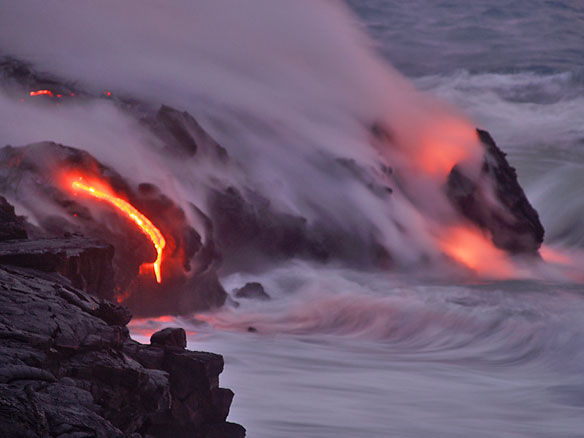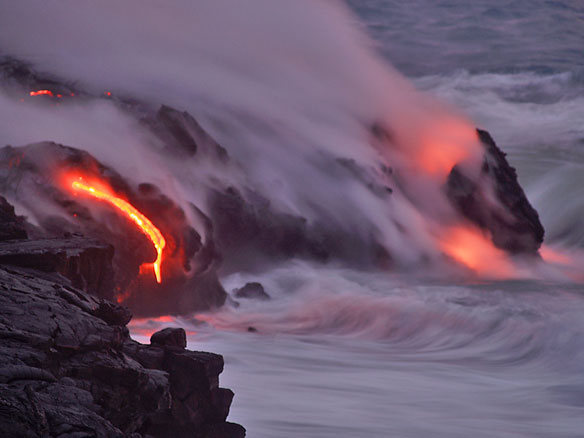
Lava is steaming as it hits the ocean. Photo Source: USGS Hawaii Volcano Observatory
Excerpt from NASA, Earth Observatory
The youngest land on Earth lies along the southern coast of the island of Hawaii, where lava from Kilauea Volcano enters the ocean.
When lava meets the sea, it vaporizes seawater and creates a dense plume of steam. Over time, the lava builds a delta, extending the shoreline of Hawaii.

NASA, September 30, 2010
From November 1986, when lava from the current eruption first reached the ocean, through December 2009, Kilauea created 192.3 hectares (475 acres) of new land.
This natural-color satellite image shows lava entering the ocean at the Puhi-o-Kalaikini Delta. It was acquired by the Advanced Land Imager (ALI) aboard Earth Observing-1 (EO-1) on September 28, 2010. Black areas are fresh lava flows, the earliest of which were laid down from 1986 to 1992.

NASA, September 28, 2010
Activity along this section of coast resumed in 2007, with breakouts earlier this year encroaching on the town of Kalapana, which was partially covered in 1990 and 1991. Healthy vegetation is green, while vegetation scorched by recent lava flows is brown. Trade winds blow the white plume to the west.
Kilauea means “spewing” or “much spreading” in the Hawaiian language, referring to its frequent outpouring of lava. The PuʻuʻŌʻō cone has been continuously erupting since 1983, making it the longest rift-zone eruption of the last 200 years. Since 1952, there have been 33 eruptions, not including the current episode.
The volume of erupted material from Kilauea covering the land there is enough to pave a road across the world three times, making it one of the most active volcanoes on the planet.
The image is accompanied by an aerial photograph taken on September 30 by the U.S. Geological Survey’s Hawaii Volcano Observatory.
When Lava Enters the Sea, Growth & Collapse of Lava Deltas, USGS
When lava enters the ocean for extended periods of time, new land is created in the form of a fan-shaped platform known as a lava delta. Lava pouring into the ocean from either surface flows or lava tubes cools rapidly, usually shattering into sand- to block-size fragments. These fragments accumulate along the submarine slope to form a loose foundation that will eventually support overlying lava flows that build the delta above sea level. Photo Source: USGS









